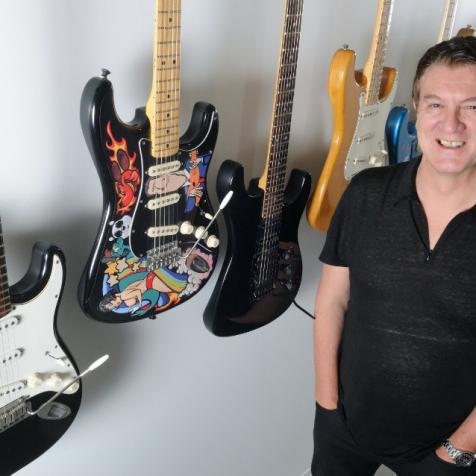
Company Details
Location
Corona, California
Founded
1946
Ownership Type
Private
Employees
2,000
Products
Musical instruments and electronics
Corona, California (headquarters: Scottsdale, Arizona)
Founded: 1946
Privately owned
Employees: 2,000 (about 1,000 in U.S.)
Industry: Consumer & Lifestyle
Products: Musical instruments and electronics
CEO Andy Mooney oversees the industry leader, but still takes the time to listen to what professional musicians want in a guitar.
When professional musicians shop for a Fender guitar, they look for the model manufactured in Corona. They know that this is where the premium products are made, but don't often realize it took more than 30 years to get there from the time Leo Fender started the company in 1946 in Fullerton, California.
A legendary guitar innovator, Leo Fender suffered from health issues and sold the company to CBS in 1965. After tremendous growth but dwindling commitment, an investment group led by William Schultz bought the company in 1985 and started the Fender Musical Instrument Corporation. The new company reinvigorated itself and began importing instruments from overseas, but the move towards greater quality led to the opening of the Corona plant in 1985. The thriving plant became the company's flagship and also spawned the Fender Custom Shop, where professionals go to create custom instruments from talented artisans and luthiers.

Although Mooney operates out of the Hollywood office, the company has facilities around the U.S. and globally. The 250,000-square-foot Corona, California manufacturing plant, however, is special. It's where Leo Fender's traditions of making musical instruments are still carried out. "Corona is center stage for all of our aspirations," says Mooney. "There has always been and continues to be a distinguishable quality that comes out of our Corona plant. We use the finest woods, highest quality components and emphasize, craftsmanship throughout this facility. The Corona plant continues to be the producer of the highest quality instruments we manufacture."
As one might imagine, Fender's work force in the Corona plant has high levels of pride. "There are lots of dedicated employees that have been there 20-plus years," says Mooney. "That pride dates far back. If you dismantle a guitar from 1955 you would find the personal stamp of the man or woman who built that part of the guitar stenciled on the neck or body."

The workforce at the Corona plant is artisans bolstered by automation technology. "We use robots for painting the undercoat and topcoat," says Mooney. "We've been doing that since 2013. When you consider the nooks and crannies in the product, the robotics take away the strain from the workers and offers more consistency. The color, however, we continue to apply by hand. Leo focused on wood for its tonal qualities but he painted with auto industry paint. He took a paint that wouldn't normally be applied to a wood surface and it has been a distinguishing feature of the product over the years. It's the handwork that brings a uniqueness to our product."
Ed Magee, SVP of operations, points out that many of the workers eventually become experts in the luthiery craft. "We look for young adults, college, and post-high school students, who love woodworking and partner with local community colleges and universities to find prospective employees who are good with their hands," says Magee. "The best employees aspire to be members of Corona's Custom Shop to expand their capabilities. Essentially, the factory is a luthier school and houses the best of the best."

Ultimately, musicians are the best form of marketing and Fender instruments continue to be used by a majority of famous artists. "One of the key elements to Fender's continued success is the fact that Leo never played the guitar," says Mooney. "He was a profoundly good listener and gave professional musicians exactly what they wanted in an electrified instrument. Listening to the artists over the decades has resulted in 80 to 90 percent of professional artists now playing Fender guitars. This, in turn, has led to greater market share for the company."
Challenges: "We just faced a wood challenge," says Mooney. "Rosewood is an endangered species and North American ash, our primary wood form, is under threat from beetles. We're constantly searching for alternate wood options that produce optimal tonal qualities, but still, allow us to be environmentally responsible. Most of our wood is domestic wood and very few exotics. The Custom Shop is where we experiment and explore. We used recovered wood from the Hollywood Bowl and redwood timber from the Santa Cruz boardwalk. We have a wood expert that searches for wood around the world that feature unique tonal qualities and a unique story."

Opportunities: "When he formed this company, Leo created three foundational pillars that we feel give us more opportunities than our competition," says Mooney. "One of Leo's tenets was that form should always follow function in product design. The basic forms Leo designed in the '50s and '60s remain intact as a result, but every nuance of the finished guitar has changed in terms of how the guitar feels and sounds. The shape of the neck, the height of the frets, the pickups, and electronics have all evolved, but they've evolved for a reason. On a more philosophical level, Leo believed that artists were angels and his job was to give them wings. Not many people can claim to have that as a part of their job description."
Needs: "We are always looking for bright new faces," says Magee. "We've had some really good workers in the factory who are also incredible musicians. We have an event called Band Jam where we go to different facilities and have employee bands play. It's one of the best internal events that make Fender an incredible place to work. We have incredibly talented musicians who are also making an impact on the physical products we make."

